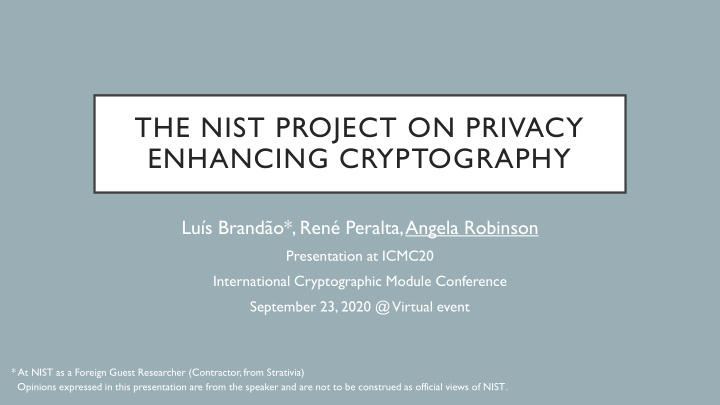



THE NIST PROJECT ON PRIVACY ENHANCING CRYPTOGRAPHY Luís Brandão*, René Peralta, Angela Robinson Presentation at ICMC20 International Cryptographic Module Conference September 23, 2020 @ Virtual event * At NIST as a Foreign Guest Researcher (Contractor, from Strativia) Opinions expressed in this presentation are from the speaker and are not to be construed as official views of NIST .
OUTLINE 1. The NIST PEC project 2. PEC techniques 3. Example applications of interest 4. PEC considerations 2
OUTLINE 1. The NIST PEC project 2. PEC techniques 3. Example applications of interest 4. PEC considerations 3
THE NIST CRYPTO GROUP 4
PRIVACY ENHANCING CRYPTO (PEC) Goal : follow the progress of emerging technologies in the area of PEC and promote the use of cryptographic protocols that facilitate privacy goals • Various primitives of interest: • Zero-knowledge proofs (ZKP) • Secure multiparty computation (SMPC) • Fully homomorphic encryption (FHE), identity-based encryption (IBE), etc. • Development of reference material • Privacy-enhancing applications https://csrc.nist.gov/Projects/Privacy-Enhancing-Cryptography 5
REFERENCE MATERIAL Assess the state of the Motivate real-use art or research in a applications or proofs particular area of concept Frame development of Promote standards and future interoperability for discussions useful applications 6
OUTLINE 1. The NIST PEC project 2. PEC techniques 3. Example applications of interest 4. PEC considerations 7
ZERO-KNOWLEDGE PROOFS (ZKP) Example [GMW91]: how to demonstrate the knowledge of a valid graph tri- coloration, without revealing any information about the solution? Example: Consider this graph of • 12 vertices: {A,B,C,D,E,F,G,H,I,J,K,L} • 17 edges: {AB, AF, BC, BE, BF, CD, CE, DH, DJ, EF, EH, GH, HI, HL, IJ, IK, JK} 8
ZERO-KNOWLEDGE PROOFS (ZKP) Example [GMW91]: how to demonstrate the knowledge of a valid tri-coloration, without revealing any information about the solution? ZKP . Many iterations of the following: 1. 1. Permute the colors 2. 2. Commit to all permuted colors 3. 3. Reveal an edge selected by the verifier The verifier accepts if each revealed edge has two distinct colors 9
SECURE MULTIPARTY COMPUTATION (SMPC) Since [Yao82]: allows multiple (distrustful) parties to jointly compute a function of their distributed inputs, while retaining privacy and correctness of each input and output Secure two-party computation (S2PC) can be used for blind enciphering AES128: advanced encryption standard (a block-cipher) with 128 bits of key-size and plaintext-size. 10
SECURE MULTIPARTY COMPUTATION (SMPC) Since [Yao82]: allows multiple (distrustful) parties to jointly compute a function of their distributed inputs, while retaining privacy and correctness of each input and output Secure two-party computation (S2PC) can be used for privacy preserving data mining 11
OUTLINE 1. The NIST PEC project 2. PEC techniques 3. Example applications of interest 4. PEC considerations 12
A U.S. Congress bill (2019) mandates the use of SMPC (or equivalent) to estimate the return on investment by students on their college education . https://www.congress.gov/bill/116th-congress/house-bill/1565 The data is distributed across several entities: SSA, Treasury, VA, Universities. Due to privacy concerns, these entities cannot share their data. USE CASE: Approach: data holders encrypt the relevant data, then do SMPC to calculate STUDENTS’ aggregate statistics RIGHT TO KNOW 13
USE CASE: ENCOUNTER METRICS Goal: measure aggregate levels of encounters in a population while preserving the privacy of individuals • Measurements useful for making informed decisions about occupancy rates and mobility rules • We classify encounters according to distance between persons during and time of interaction Application: privacy-preserving exposure notification • Allows one to obtain a measure of their risk due to past encounters with self- reported COVID-19 positive people • The precise engineering of a system for exposure notification should be targeted to particular environments 14
OUTLINE 1. The NIST PEC project 2. PEC techniques 3. Example applications of interest 4. PEC considerations 15
CONSIDERATIONS What kind of PEC could/should “Secure Cryptographic Modules” support? • ZKPs about stored secret keys • Private set intersection between two HSMs to determine a common subset (intersection), without revealing each others' private lists of data • Participate in SMPC of key-generation (e.g., RSA or ECC), ending with a secret-share in each HSM • Participate in a signature generation (e.g., RSA, ECDSA, EdDSA), without ever reconstructing the key We welcome and encourage feedback from the community. 16
CURRENT ACTIVITIES Collaboration with ZKProof initiative • Open-industry academic initiative that seeks to mainstream (ZKP) cryptography • ZKProof Community Reference • NIST PEC official comments • Involvement in editorial process https://csrc.nist.gov/Projects/pec/zkproof 17
CURRENT ACTIVITIES “Special Topics on Privacy and Public Auditability” speaker series, first event: • What math and physics can do to combat fake videos Differential Privacy at the US Census Bureau: Status Report • De-Identification and Differential Privacy • • Randomness beacons as enablers of public auditability https://csrc.nist.gov/Projects/pec/stppa Privacy-preserving encounter metrics and exposure notification Approach to mitigate privacy concerns related to automated contact tracing efforts • • To appear 18
Foreseeable synergies with other projects: • Privacy preserving public auditability, as enabled by randomness beacons • SMPC is useful for threshold cryptography (compute on secret-shared key) • Some post-quantum cryptographic schemes are based on PEC (and vice-versa) • Efficient ZKPs and SMPC depend strongly on good circuits PEC AND OTHER with low complexity CRYPTOGRAPHY 19
The NIST PEC team: • Luís Brandão THANKS • René Peralta FOR YOUR • Angela Robinson ATTENTION Contact us at crypto-privacy@nist.gov 20
Recommend
More recommend